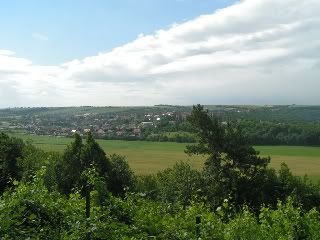The Nebra Sky Disc – Ancient Map of the Stars
 Ancient Astronomy
Ancient Astronomy
Some researchers have pointed to the presence of the Pleiades star cluster on the disc as further evidence of Bronze Age astronomical knowledge. Although nowadays there are only six stars in the Pleiades visible to the naked eye, in the Bronze Age one of the group stars may have been much brighter, thus accounting not only for the depiction of seven stars on the disc, but also for the ancient Greek name for the cluster – the ‘Seven Sisters’.
The Pleiades was an important constellation for many ancient civilisations, including those of Mesopotamia and Greece. The constellation would have appeared in their skies in the autumn, showing that it was time to start bringing in the harvest, and disappeared in the spring, indicating the time for planting crops. This evidence for the importance of the disc in connection with prehistoric agriculture may mean that the (third) golden arc underneath the crescent moon and golden disc in fact represents a sickle.
Others have suggested that the disc actually represents the day-time sky and that the unexplained arc depicts a rainbow. But the majority of researchers believe this third arc to be a ‘sun ship’. There are depictions of a disk in a ship from Bronze Age Scandinavia, and a Danish artefact dating to the 15th / 14th century BC, the ‘Trundholm Sun Chariot’, depicts a horse drawing the sun in a chariot. But the main source of the symbol and the ancient belief that a ship carried the sun across the night sky from the Western to Eastern horizon is Egypt. Their belief was that Rah, the sun god and their most potent deity, journeyed through the night sky on a ship in order that in the morning, at sunrise, he could be reborn.
If the golden arc at the bottom of the Nebra disk does in fact represent a sun ship travelling across the night sky, then it will be the first evidence of such a belief in central Europe.
Germany’s Stonehenge – The Goseck Circle
There is further proof of prehistoric celestial knowledge in the area, a mere 25km distant from where the Nebra disc was discovered. Lying in a wheat field near the town of Goseck, and first identified from aerial photographs, is the remains of what is thought to be Europe’s oldest observatory. ‘Germany’s Stonehenge’ as it has become known, consists of a huge a huge circle, 75m in diameter, and was built by the earliest farming communities in the area around 4,900 BC. Originally the site consisted of four concentric circles, a mound, a ditch and two wooden palisades about the height of a person.
Within the palisades were three sets of gates, facing southeast, southwest and north, respectively. The two southern gates marked the sunrise and sunset of both the summer and winter solstice. At the the winter solstice, watchers at the centre of the circles would have witnessed the sun rise and set through the south east and south west gates. It is surely safe to assume that if these southern gates marked the sunrise and sunset at the winter and summer solstice, then the inhabitants of Goseck were able to accurately determine the course of the sun in its journey across the sky. In fact the angle between the two solstice gates in the Goseck circle corresponds with the angle between the gilded arcs on the rim of the Nebra skydisk.
Although the Nebra disk was created 2,400 years later than the Goseck site, Professor Wolfhard Schlosser believes there may be some connection between the two in the astronomical knowledge they both display. Schlosser has even suggested that the details on the disc were based on previous astrological observations, possibly made at the primitive observatory at Goseck.
Is the Nebra Disc a Hoax?
In late 2004, the Nebra disc became enmeshed in controversy. German archaeologist Professor Peter Schauer, of Regensburg University, claimed that the disk was a modern fake, and any idea that it was a Bronze Age map of the heavens was ‘a piece of fantasy’. Professor Schauer stated that the supposedly Bronze Age green patina on the artefact had probably been artificially created in a workshop ‘using acid, urine and a blowtorch’ and was not ancient at all. The holes around the edge of the disc, he insisted, were too perfect to be ancient, and must have been made by a relatively modern machine. His own conclusion was that the object was a 19th century Siberian Shaman’s drum.
However, it later emerged that Schauer had never studied the artefact himself prior to making his claim, nor did he publish any of his theories in a peer-reviewed journal. But Schauer’s objections still shocked the German archaeological community and raised some important questions about the authenticity of the disc.
The first was that, because of the circumstances of its discovery, the Nebra disc had no secure archaeological context. Thus it was extremely difficult to date accurately, especially as there was nothing similar with which to compare it. The dating that was done on the object depended upon the typological dating of the Bronze Age weapons which had been offered for sale with it, and were supposed to be from the same site. These axes and swords were dated to the middle of the 2nd millennium BC.
Solid evidence for the antiquity of the disc was provided by the Halle Institute for Archaeological Research in Germany. The Institute submitted the artifact to an exhaustive series of tests that confirm its authenticity. For example the copper used on the disc has been traced to a Bronze Age mine deep in the Austrian Alps. Tests also discovered that a practically unique mixture of hard crystal malachite covers the artefact. In addition to this, microphotography of the corrosion on the disc has also produced images that proved that it was a genuinely ancient artifact, and could not be have been produced by a faker.
The latest examinations of the disc, by a group of German scholars in early 2006, came to the conclusion that it was indeed genuine, and had functioned as a complex astronomical clock for the synchronization of solar and lunar calendars. In 2010 scientists at Mainz and Halle Wittenberg universities in Germany speculated that the Disc may have fallen out of use after the catastrophic volcanic eruption on the Mediterranean island of Thera (modern Santorini). The scientists believe that the huge blanket of ash that obscured the sky perhaps all the way to Central Europe for two or three decades brought an end to the cult of sun worshipping. Their faith shaken by the effects of the eruption – reduced temperatures, crop failures, the culture which manufactured the Nebra Sky Disc simply discarded the artifact.
The Nebra Sky Disc is the earliest known guide to the heavens yet discovered, and certainly, along with the Goseck site, the first examples of detailed astronomical knowledge in Europe. But perhaps that is not the end of the story. Wolfhard Schlosser believes, intriguingly, that the disc, currently valued at $11.2 million, was one of a pair, and that the other is still out there waiting to be found, somewhere at the Nebra site.
Further Reading
www.archlsa.de/sterne – The Nebra Disc on the Official Landesmuseum website.
www.bbc.co.uk/science/horizon/2004/stardisctrans.shtml – BBC Horizon documentary of the Disc.
www.dw-world.de/dw/article/0,2144,1915398,00.html – ‘Bronze Age Sky Disc Deciphered.’
Read more about the Nebra Sky Disc
in my book Hidden History
Pages: 1 2





